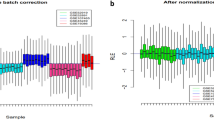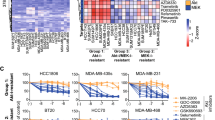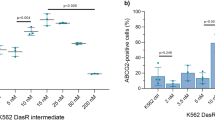Abstract
Imatinib (imatinib mesylate, STI-571, Gleevec) is a selective BCR-ABL tyrosine kinase inhibitor that has been used as a highly effective chemoagent for treating chronic myelogenous leukemia. However, the initial response to imatinib is often followed by the recurrence of a resistant form of the disease, which is major obstacle to many therapeutic modalities. The aim of this study was to identify the gene expression signatures that confer resistance to imatinib. A series of four resistant K562 sublines was established with different imatinib dosage (200, 400, 600 and 800 nM) and analyzed using microarray technology. The transcripts of the genes showing universal or dose-dependent expression changes across the resistant sublines were identified. The gene sets associated with the imatinib-resistance were also identified using gene set enrichment analysis. In the resistant K562 sublines, the transcription- and apoptosis-related expression signatures were upregulated, whereas those related to the protein and energy metabolism were downregulated. Several genes identified in this study such as IGF1 and RAB11A have the potential to become surrogate markers useful in a clinical evaluation of imatinib-resistant patients without BCR-ABL mutation. The expression signatures identified in this study provide insights into the mechanism of imatinib-resistance and are expected to facilitate the development of an effective diagnostic and therapeutic strategy.
This is a preview of subscription content, access via your institution
Access options
Subscribe to this journal
Receive 12 print issues and online access
$259.00 per year
only $21.58 per issue
Buy this article
- Purchase on Springer Link
- Instant access to full article PDF
Prices may be subject to local taxes which are calculated during checkout



Similar content being viewed by others
References
O'Dwyer ME, Druker BJ . Chronic myelogenous leukaemia – new therapeutic principles. J Intern Med 2001; 250: 3–9.
Druker BJ, Sawyers CL, Kantarjian H, Resta DJ, Reese SF, Ford JM et al. Activity of a specific inhibitor of the BCR-ABL tyrosine kinase in the blast crisis of chronic myeloid leukemia and acute lymphoblastic leukemia with the Philadelphia chromosome. N Engl J Med 2001; 344: 1038–1042.
Hochhaus A, Kreil S, Corbin A, La RP, Lahaye T, Berger U et al. Roots of clinical resistance to STI-571 cancer therapy. Science 2001; 293: 876–880.
Shah NP, Nicoll JM, Nagar B, Gorre ME, Paquette RL, Kuriyan J et al. Multiple BCR-ABL kinase domain mutations confer polyclonal resistance to the tyrosine kinase inhibitor imatinib (STI571) in chronic phase and blast crisis chronic myeloid leukemia. Cancer Cell 2002; 2: 117–125.
Gorre ME, Mohammed M, Ellwood K, Hsu N, Paquette R, Rao PN et al. Clinical resistance to STI-571 cancer therapy caused by BCR-ABL gene mutation or amplification. Science 2001; 293: 876–880.
Donato NJ, Wu JY, Stapley J, Gallick G, Lin H, Arlinghaus R et al. BCR-ABL independence and LYN kinase overexpression in chronic myelogenous leukemia cells selected for resistance to STI571. Blood 2003; 101: 690–698.
Hofmann WK, de VS, Elashoff D, Gschaidmeier H, Hoelzer D, Koeffler HP et al. Relation between resistance of Philadelphia-chromosome-positive acute lymphoblastic leukaemia to the tyrosine kinase inhibitor STI571 and gene-expression profiles: a gene-expression study. Lancet 2002; 359: 481–486.
Mahon FX, Deininger MW, Schultheis B, Chabrol J, Reiffers J, Goldman JM et al. Selection and characterization of BCR-ABL positive cell lines with differential sensitivity to the tyrosine kinase inhibitor STI571: diverse mechanisms of resistance. Blood 2000; 96: 1070–1079.
Hegedus T, Orfi L, Seprodi A, Varadi A, Sarkadi B, Keri G . Interaction of tyrosine kinase inhibitors with the human multidrug transporter proteins, MDR1 and MRP1. Biochim Biophys Acta 2002; 1587: 318–325.
Widmer N, Colombo S, Buclin T, Decosterd LA . Functional consequence of MDR1 expression on imatinib intracellular concentrations. Blood 2003; 102: 1142.
Tipping AJ, Deininger MW, Goldman JM, Melo JV . Comparative gene expression profile of chronic myeloid leukemia cells innately resistant to imatinib mesylate. Exp Hematol 2003; 31: 1073–1080.
Ohmine K, Nagai T, Tarumoto T, Miyoshi T, Muroi K, Mano H et al. Analysis of gene expression profiles in an imatinib-resistant cell line, KCL22/SR. Stem Cells 2003; 21: 315–321.
Huber W, von HA, Sultmann H, Poustka A, Vingron M . Variance stabilization applied to microarray data calibration and to the quantification of differential expression. Bioinformatics 2002; 18: S96–S104.
Eisen MB, Spellman PT, Brown PO, Botstein D . Cluster analysis and display of genome-wide expression patterns. Proc Natl Acad Sci USA 1998; 95: 14863–14868.
Tseng YH, Butte AJ, Kokkotou E, Yechoor VK, Taniguchi CM, Kriauciunas KM et al. Prediction of preadipocyte differentiation by gene expression reveals role of insulin receptor substrates and necdin. Nat Cell Biol 2005; 7: 601–611.
Bartholomew DJ . A test of homogeneity for ordered alternatives. Biometrika 1959; 46: 36–48.
Storey JD, Tibshirani R . Statistical significance for genomewide studies. Proc Natl Acad Sci USA 2003; 100: 9440–9445.
Harris MA, Clark J, Ireland A, Lomax J, Ashburner M, Foulger R et al. The Gene Ontology (GO) database and informatics resource. Nucleic Acids Res 2004; 32: D258–D261.
Kanehisa M, Goto S, Kawashima S, Nakaya A . The KEGG databases at GenomeNet. Nucleic Acids Res 2002; 30: 42–46.
Dahlquist KD, Salomonis N, Vranizan K, Lawlor SC, Conklin BR . GenMAPP, a new tool for viewing and analyzing microarray data on biological pathways. Nat Genet 2002; 31: 19–20.
Kim SY, Volsky DJ . PAGE: parametric analysis of gene set enrichment. BMC Bioinform 2005; 6: 144.
Livak KJ, Schmittgen TD . Analysis of relative gene expression data using real-time quantitative PCR and the 2(−Delta Delta C(T)) Method. Methods 2001; 25: 402–408.
Aster JC, Pear WS . Notch signaling in leukemia. Curr Opin Hematol 2001; 8: 237–244.
Zeng Q, Li S, Chepeha DB, Giordano TJ, Li J, Zhang H et al. Crosstalk between tumor and endothelial cells promotes tumor angiogenesis by MAPK activation of Notch signaling. Cancer Cell 2005; 8: 13–23.
Zumkeller W . IGFs and IGFBPs: surrogate markers for diagnosis and surveillance of tumour growth? Mol Pathol 2001; 54: 285–288.
Stallings JD, Tall EG, Pentyala S, Rebecchi MJ . Nuclear translocation of phospholipase C-delta1 is linked to the cell cycle and nuclear phosphatidylinositol 4, 5-bisphosphate. J Biol Chem 2005; 280: 22060–22069.
Toby GG, Gherraby W, Coleman TR, Golemis EA . A novel RING finger protein, human enhancer of invasion 10, alters mitotic progression through regulation of cyclin B levels. Mol Cell Biol 2003; 23: 2109–2122.
Bao J, Zervos AS . Isolation and characterization of Nmi, a novel partner of Myc proteins. Oncogene 1996; 12: 2171–2176.
Tsuruoka S, Ishibashi K, Yamamoto H, Wakaumi M, Suzuki M, Schwartz GJ et al. Functional analysis of ABCA8, a new drug transporter. Biochem Biophys Res Commun 2002; 298: 41–45.
Matsumoto N, Yoneda-Kato N, Iguchi T, Kishimoto Y, Kyo T, Sawada H et al. Elevated MLF1 expression correlates with malignant progression from myelodysplastic syndrome. Leukemia 2000; 14: 1757–1765.
Gebhardt C, Breitenbach U, Richter KH, Furstenberger G, Mauch C, Angel P et al. c-Fos-dependent induction of the small ras-related GTPase Rab11a in skin carcinogenesis. Am J Pathol 2005; 167: 243–253.
Mootha VK, Lindgren CM, Eriksson KF, Subramanian A, Sihag S, Lehar J et al. PGC-1alpha-responsive genes involved in oxidative phosphorylation are coordinately downregulated in human diabetes. Nat Genet 2003; 34: 267–273.
Holyoake TL, Jiang X, Jorgensen HG, Graham S, Alcorn MJ, Laird C et al. Primitive quiescent leukemic cells from patients with chronic myeloid leukemia spontaneously initiate factor-independent growth in vitro in association with up-regulation of expression of interleukin-3. Blood 2001; 97: 720–728.
Elliott RL, Blobe GC . Role of transforming growth factor Beta in human cancer. J Clin Oncol 2005; 23: 2078–2093.
Yan Z, Deng X, Friedman E . Oncogenic Ki-ras confers a more aggressive colon cancer phenotype through modification of transforming growth factor-beta receptor III. J Biol Chem 2001; 276: 1555–1563.
Mandanas RA, Leibowitz DS, Gharehbaghi K, Tauchi T, Burgess GS, Miyazawa K et al. Role of p21 RAS in p210 bcr-abl transformation of murine myeloid cells. Blood 1993; 82: 1838–1847.
Acknowledgements
We thank the Korean Leukemia Cell and Gene Bank for providing the imatinib-resistant CML samples and S Yim for critical appraisal of this paper. This study was supported by a grant of the Korea Health 21 R&D Project, Ministry of Health & Welfare, Republic of Korea (0405-BC02-0604-0004), the Catholic Medical Center Research Foundation (2004) and Ministry of Science and Technology (2004-01303; M1-0416-22-0006), Republic of Korea.
Author information
Authors and Affiliations
Corresponding author
Additional information
Supplementary Information accompanies the paper on the Leukemia website (http://www.nature.com/leu)
Supplementary information
Rights and permissions
About this article
Cite this article
Chung, YJ., Kim, TM., Kim, DW. et al. Gene expression signatures associated with the resistance to imatinib. Leukemia 20, 1542–1550 (2006). https://doi.org/10.1038/sj.leu.2404310
Received:
Revised:
Accepted:
Published:
Issue Date:
DOI: https://doi.org/10.1038/sj.leu.2404310
Keywords
This article is cited by
-
Exome, transcriptome and miRNA analysis don’t reveal any molecular markers of TKI efficacy in primary CML patients
BMC Medical Genomics (2019)
-
Cobll1 is linked to drug resistance and blastic transformation in chronic myeloid leukemia
Leukemia (2017)
-
Reduced tumorigenicity and pathogenicity of cervical carcinoma SiHa cells selected for resistance to cidofovir
Molecular Cancer (2013)
-
Gene expression signatures associated with the in vitro resistance to two tyrosine kinase inhibitors, nilotinib and imatinib
Blood Cancer Journal (2011)
-
MicroRNA expression profiling in Imatinib-resistant Chronic Myeloid Leukemia patients without clinically significant ABL1-mutations
Molecular Cancer (2009)



